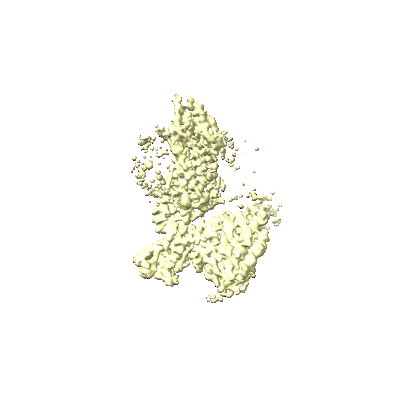EMD-33070
Cryo-EM structure of neuropeptide Y Y2 receptor in complex with NPY and Gi
EMD-33070
Single-particle3.4 Å
 Deposition: 15/03/2022
Deposition: 15/03/2022Map released: 18/05/2022
Last modified: 18/05/2022
Sample Organism:
Homo sapiens
Sample: Neuropeptide Y Y2 receptor in complex with NPY and Gi
Fitted models: 7x9b (Avg. Q-score: 0.394)
Deposition Authors: Tang T ,
Han S
,
Han S  ,
Zhao Q
,
Zhao Q  ,
Wu B
,
Wu B 
Sample: Neuropeptide Y Y2 receptor in complex with NPY and Gi
Fitted models: 7x9b (Avg. Q-score: 0.394)
Deposition Authors: Tang T
 ,
Han S
,
Han S  ,
Zhao Q
,
Zhao Q  ,
Wu B
,
Wu B 
Receptor-specific recognition of NPY peptides revealed by structures of NPY receptors.
Tang T  ,
Tan Q
,
Tan Q  ,
Han S
,
Han S  ,
Diemar A
,
Diemar A  ,
Lobner K,
Wang H,
Schuss C
,
Lobner K,
Wang H,
Schuss C  ,
Behr V
,
Behr V  ,
Morl K
,
Morl K  ,
Wang M
,
Wang M  ,
Chu X
,
Chu X  ,
Yi C
,
Yi C  ,
Keller M
,
Keller M  ,
Kofoed J,
Reedtz-Runge S
,
Kofoed J,
Reedtz-Runge S  ,
Kaiser A
,
Kaiser A  ,
Beck-Sickinger AG
,
Beck-Sickinger AG  ,
Zhao Q
,
Zhao Q  ,
Wu B
,
Wu B 
(2022) Sci Adv , 8 , eabm1232 - eabm1232
 ,
Tan Q
,
Tan Q  ,
Han S
,
Han S  ,
Diemar A
,
Diemar A  ,
Lobner K,
Wang H,
Schuss C
,
Lobner K,
Wang H,
Schuss C  ,
Behr V
,
Behr V  ,
Morl K
,
Morl K  ,
Wang M
,
Wang M  ,
Chu X
,
Chu X  ,
Yi C
,
Yi C  ,
Keller M
,
Keller M  ,
Kofoed J,
Reedtz-Runge S
,
Kofoed J,
Reedtz-Runge S  ,
Kaiser A
,
Kaiser A  ,
Beck-Sickinger AG
,
Beck-Sickinger AG  ,
Zhao Q
,
Zhao Q  ,
Wu B
,
Wu B 
(2022) Sci Adv , 8 , eabm1232 - eabm1232
Abstract:
In response to three highly conserved neuropeptides, neuropeptide Y (NPY), peptide YY, and pancreatic polypeptide (PP), four G protein-coupled receptors mediate multiple essential physiological processes, such as food intake, vasoconstriction, sedation, and memory retention. Here, we report the structures of the human Y1, Y2, and Y4 receptors in complex with NPY or PP, and the Gi1 protein. These structures reveal distinct binding poses of the peptide upon coupling to different receptors, reflecting the importance of the conformational plasticity of the peptide in recognizing the NPY receptors. The N terminus of the peptide forms extensive interactions with the Y1 receptor, but not with the Y2 and Y4 receptors. Supported by mutagenesis and functional studies, subtype-specific interactions between the receptors and peptides were further observed. These findings provide insight into key factors that govern NPY signal recognition and transduction, and would enable development of selective drugs.
In response to three highly conserved neuropeptides, neuropeptide Y (NPY), peptide YY, and pancreatic polypeptide (PP), four G protein-coupled receptors mediate multiple essential physiological processes, such as food intake, vasoconstriction, sedation, and memory retention. Here, we report the structures of the human Y1, Y2, and Y4 receptors in complex with NPY or PP, and the Gi1 protein. These structures reveal distinct binding poses of the peptide upon coupling to different receptors, reflecting the importance of the conformational plasticity of the peptide in recognizing the NPY receptors. The N terminus of the peptide forms extensive interactions with the Y1 receptor, but not with the Y2 and Y4 receptors. Supported by mutagenesis and functional studies, subtype-specific interactions between the receptors and peptides were further observed. These findings provide insight into key factors that govern NPY signal recognition and transduction, and would enable development of selective drugs.
